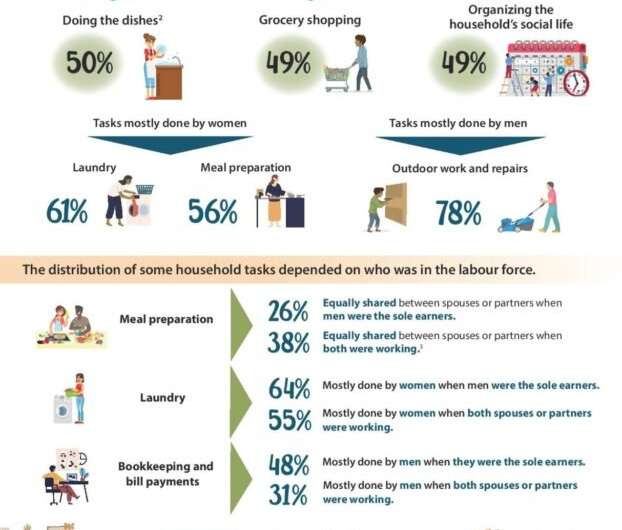Credit: University of Western Ontario
Canadian couples still divide most household chores along traditional lines—even though women and men, overall, share more home duties more than ever, a new Statistics Canada study of opposite-sex couples shows.
It's an age-old division of labor unlikely to shift much until parents routinely expect their daughters to mow the lawn and their sons to do laundry, Western Sociology professor Michael Haan says.
"The seeds of gender roles are planted way before people are married," said Haan, Canada Research Chair in Migration and Ethnic Studies and Academic Director of the Statistics Canada Research Data Centre at Western.
While who does what in the home is often a matter of negotiation in a relationship, it's also a function of how the pair themselves were raised to understand household chores and gender.
"You have to start with children when they are very young and teach them that this 'pink' job/'blue' job distinction is both fabricated and malleable," Haan said.
In a Statistics Canada summary released Wednesday, with data from the 2016 census, just 11 percent of couples in Canadian households said they equally share laundry, housework and cooking duties.
Other highlights:
- Women most often do the household laundry and cooking while men most often do outdoor work and repairs;
- Both often share equally in doing dishes, grocery-shopping and organizing the social calendar;
- Women and men who both work outside the home share more tasks more often than couples with just one paid-working spouse; and
- Couples younger than 64 years old were twice as likely to share laundry, housework and meal preparation than more senior couples.
The reasons are likely less about inclination than socialization: that women spent more time on indoor chores and men on outdoor chores when they were younger.
With experience comes efficiency and proficiency—and that may mean the partners as adults negotiate to do the tasks they've become best at, even if they don't prefer them.
"In terms of how skills are utilized within the household, it makes less sense to have a man cooking if he can't cook," Haan said.
But change is happening, albeit slowly.
"Men are getting better at this—because something like the increase in educational attainment often means that young men live on their own for a while, and they start to learn how to cook and they start to learn how to do laundry—and that's partly behind the rise, the slow rise, of egalitarianism within the home," he said.
While a low number in the census said they share jobs equally, Haan said he would love to be able to ask follow-up questions and do a "fact check" on whether the reality of chore equity is lower than their perceptions would suggest.
One data gap this time around is that Statistics Canada stopped asking the question (as it did in the 2006 census) of how many hours Canadian men and women spend on unpaid housework and unpaid childcare, Haan said. "(In 2006), it really jumped out. Women are way higher on both of those measures. They're taking care of the kids and they're taking care of the housework more than the men are."
Haan said imbalances in workload have important implications that go beyond just identifying who scrubs the toilets and who pays the bills.
In a research paper he recently submitted for publication to the Journal of Marriage and Family, Haan argues that the tradition of women as "CEO of the household' has led to limits on their mobility and careers. The research in his paper is also based on 2016 census data.
"Women tend to have a smaller geographic labor market because they have so many tasks to do at home. They can't necessarily optimize their human capital and training in the same way that men can.
"If females are responsible for the majority of household tasks, which this release suggests they are, they're not going to have time to live in London and drive to Toronto to take a job as a CEO because they have to take care of the house and take care of the children. She'll be more likely to take a job that maybe isn't a perfect fit but it's geographically close to home."
Only then can they manage their 'double day': paid work during the day and unpaid childcare and housework at night, he said. "Whereas for men, the sky's the limit. Men can travel farther to take on better jobs because they're not tethered by household responsibilities to the same extent."
Those choices, whether willing or reluctant, then reverberate through the labor market in helping perpetuate gender wage gaps, he said.
Another implication of the pink/blue separation of tasks is that the death of a spouse can be debilitating for the survivor, who may never have cooked or mowed the lawn. "They've always had this division of labor and now the individual is forced to do this on their own," he said.
"One of the big things is that people need to be reminded that these gendered roles within the household are fairly durable and they will continue to remain durable until we take a more comprehensive look at the factors that shape these norms."
The Statistics Canada data cover persons aged 20 and older in Canada who were married or living common-law at the time of the survey. Only respondents living in the same household with a spouse or partner of the opposite sex were considered. Given the nature of the analysis, which compares how household tasks are shared between genders, same-sex couples were not included in this study.
Provided by University of Western Ontario






















